On this excerpt from Unleashing the Energy of CSS, we take a deep dive into the way to choose components with the CSS :has() selector.
Heralded as “the guardian selector”, the :has() pseudo-class has far higher vary than simply styling a component’s ancestor. With its availability in Safari 15.4+ and Chromium 105+, and behind a flag in Firefox, it’s a good time so that you can develop into aware of :has() and its use circumstances.
As a pseudo-class, the essential performance of :has() is to model the component it’s connected to — in any other case referred to as the “goal” component. That is just like different pseudo-classes like :hover or :lively, the place a:hover is meant to model the <a> component in an lively state.
Nevertheless, :has() can also be just like :is(), :the place(), and :not(), in that it accepts a an inventory of relative selectors inside its parentheses. This permits :has() to create advanced standards to check towards, making it a really highly effective selector.
To get a really feel for the way :has() works, let’s have a look at an instance of the way to apply it. Within the following selector, we’re testing if an <article> component has an <img> component as a baby:
article:has(img) {}
A doable results of this selector is proven within the picture beneath. Three article components are proven, two containing pictures and each having a palegreen background and totally different padding from the one with out a picture.
The selector above will apply so long as an <img> component exists wherever with the <article> component — whether or not as a direct youngster or as a descendant of different nested components.
If we need to make sure that the rule applies provided that the <img> is a direct (un-nested) youngster of the <article> component, we are able to additionally embody the kid combinator:
article:has(> img) {}
The results of this alteration is proven within the picture beneath. The identical three playing cards are proven, however this time solely the one the place the picture is a direct youngster of the <article> has the palegreen background and padding.
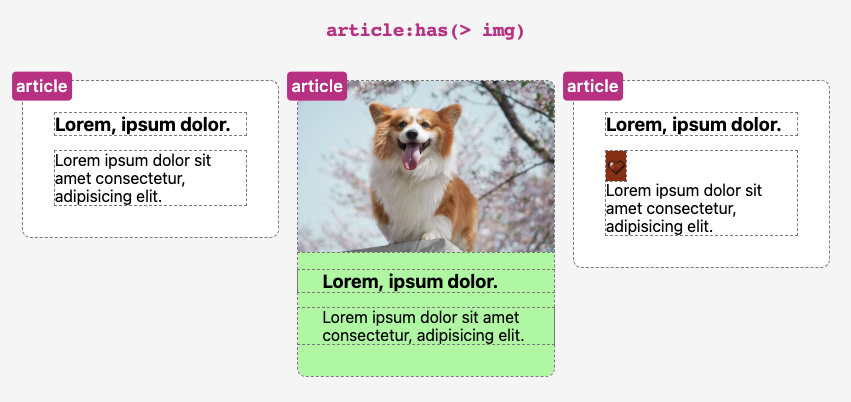
In each selectors, the kinds we outline are utilized to the goal component, which is the <article>. That is why of us usually name :has() the “guardian” selector: if sure components exist in a sure manner, their “guardian” receives the assigned kinds.
Be aware: the :has() pseudo-class itself doesn’t add any specificity weight to the selector. Like :is() and :not(), the specificity of :has() is the same as the best specificity selector within the selector checklist. For instance, :has(#id, p, .class) may have the specificity afforded to an id. For a refresher on specificity, assessment the part on specificity in CSS Grasp, third Version.
We are able to additionally choose a goal component if it’s adopted by a particular sibling component utilizing the adjoining sibling combinator (+). Within the following instance, we’re deciding on an <h1> component provided that it’s immediately adopted by an <h2>:
h1:has(+ h2) {}
Within the picture beneath, two <article> components are proven. Within the first one, as a result of the <h1> is adopted by an <h2>, the <h1> has a palegreen background utilized to it.
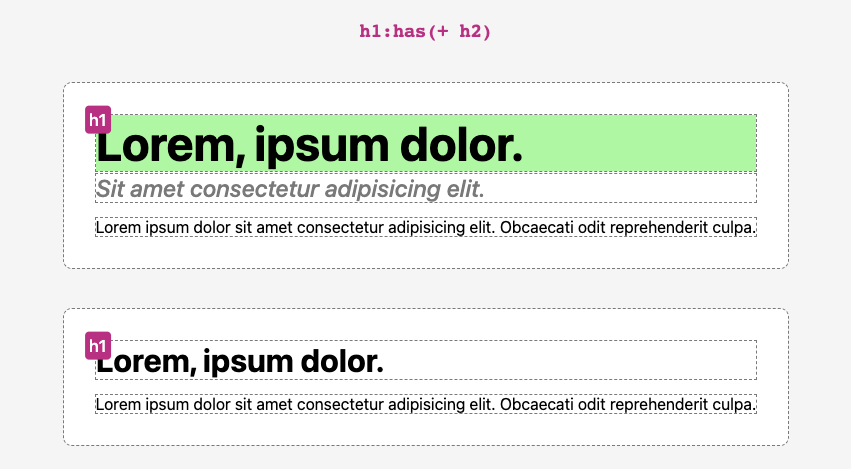
Utilizing the overall sibling combinator (~), we are able to verify if a particular component is a sibling wherever following the goal. Right here, we’re checking if there’s a <p> component someplace as a sibling of the <ul>:
ul:has(~ p) {}
The picture beneath exhibits two <article> components, every containing an unordered checklist. The second article’s checklist is adopted by a paragraph, so it has a palegreen background utilized.
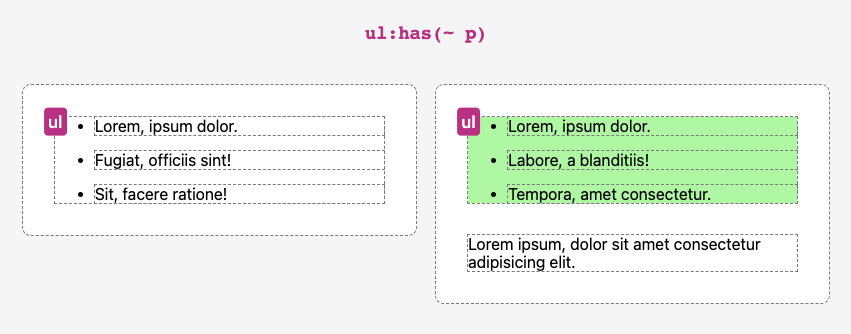
The selectors we’ve used thus far have styled the goal component connected to :has(), such because the <ul> in ul:has(~ p). Simply as with common selectors, our :has() selectors might be prolonged to be much more advanced, comparable to setting styling situations for components circuitously connected to the :has() selector.
Within the following selector, the kinds apply to any <p> components which can be siblings of an <h2> that itself has an <h3> as an adjoining sibling:
h2:has(+ h3) ~ p
Within the picture beneath, two <article> components are proven. Within the second, the paragraphs are styled with a palegreen background and an elevated left margin, as a result of the paragraphs are siblings of an <h2> adopted by an <h3>.
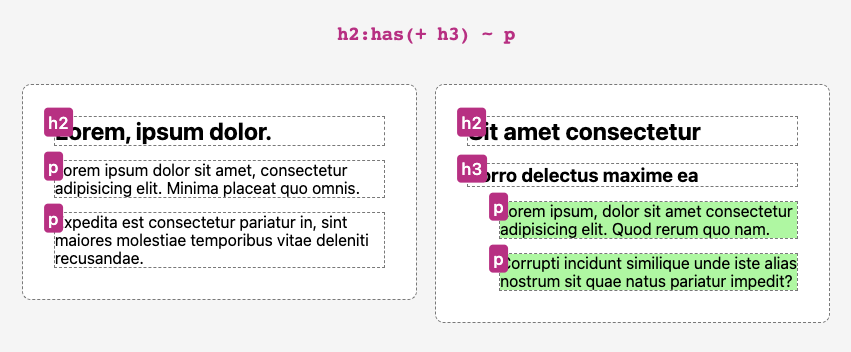
Be aware: we’ll be extra profitable utilizing :has() if we’ve a superb understanding of the obtainable CSS selectors. MDN gives a concise overview of selectors, and I’ve written a two-part sequence on selectors with further sensible examples.
Bear in mind, :has() can settle for an inventory of selectors, which we are able to consider as OR situations. Let’s choose a paragraph if it contains <a> _or_ <robust> _or_ <em>:
p:has(a, robust, em) {}
Within the picture beneath, there are two paragraphs. As a result of the second paragraph incorporates a <robust> component, it has a palegreen background.

We are able to additionally chain :has() selectors to create AND situations. Within the following compound selector, we’re testing each that an <img> is the primary youngster of the <article>, and that the <article> incorporates an <h1> adopted by an <h2>:
article:has(> img:first-child):has(h1 + h2) {}
The picture beneath exhibits three <article> components. The second article has a palegreen background (together with different styling) as a result of it incorporates each a picture as a primary youngster and an <h1> adopted by an <h2>.
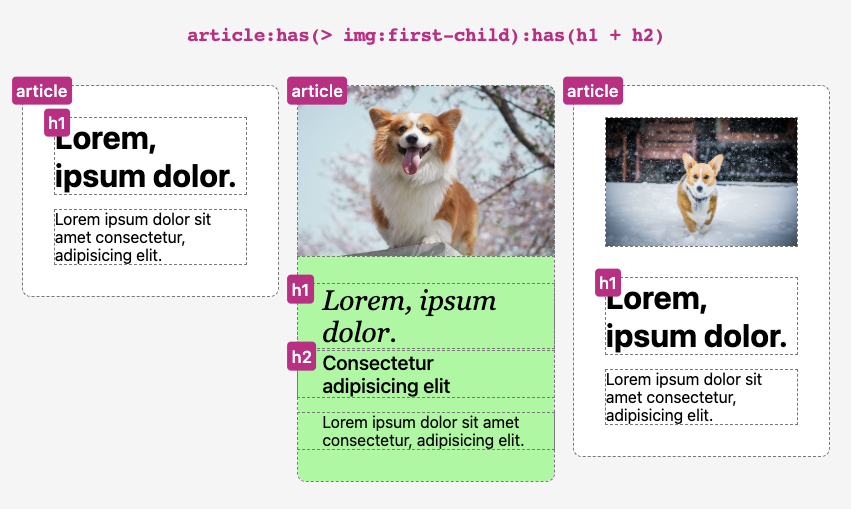
You possibly can assessment all of those fundamental selector examples within the following CodePen demo.
See the Pen
:has() selector syntax examples by SitePoint (@SitePoint)
on CodePen.
This text is excerpted from Unleashing the Energy of CSS: Superior Strategies for Responsive Person Interfaces, obtainable on SitePoint Premium.


